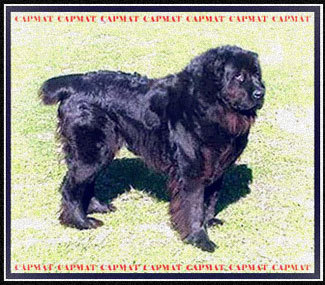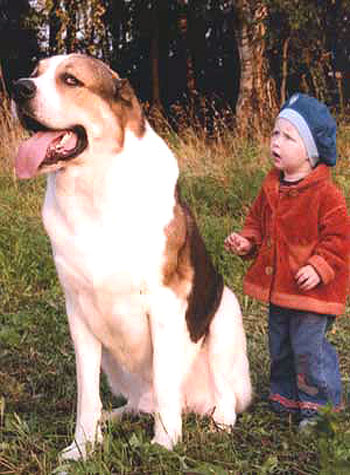Sarmatian Mastiff
 The Sarmatian Mastiff is one of the oldest breeds in the world, regarded as the key progenitor of the initial incarnation of the Alaunt, but is also related to the dogs of Central Asia, Tibet and the Caucasus. Some believe that its closest cousin is the Balkarian type of the Caucasian Ovcharka, while others link it to the Sage Koochee of Afghanistan and the ancient Assyrian Mastiff. It is interesting to note that one theory links the Sarmat to the Molossers of the Balkans, these colossal dark working dogs presumably having been brought to the region by a portion of the returning Serbian tribes, but some argue that it is more likely that the earlier journeys of these same tribes have taken the Sarmatian Mastiffs to the Balkans, where they've been assimilated into the original proto-Molossian population. Whether the link between the Sarmatian and Balkan dogs is a result of the travels in a single direction or a two-way exchange, it is still seen as very real, with the connection remaining strong to this day. The great Sarmat Dog is falsely seen as a regional type of the Central Asian Shepherd breed, even though the differences in physical built and temperament are quite noticeable, with the Sarmatian dogs being closer to the Caucasian and Sylvan stock than anything else. Having been shaped by the the nomadic life in harsh climates of the steppes in southern Ural, this is a rugged, uncomplicated and resilient dog, possessing a fairly sharp personality, but also great intelligence and ability to differentiate between true and false danger, making it an excellent property guardian and companion for experienced owners.
The Sarmatian Mastiff is one of the oldest breeds in the world, regarded as the key progenitor of the initial incarnation of the Alaunt, but is also related to the dogs of Central Asia, Tibet and the Caucasus. Some believe that its closest cousin is the Balkarian type of the Caucasian Ovcharka, while others link it to the Sage Koochee of Afghanistan and the ancient Assyrian Mastiff. It is interesting to note that one theory links the Sarmat to the Molossers of the Balkans, these colossal dark working dogs presumably having been brought to the region by a portion of the returning Serbian tribes, but some argue that it is more likely that the earlier journeys of these same tribes have taken the Sarmatian Mastiffs to the Balkans, where they've been assimilated into the original proto-Molossian population. Whether the link between the Sarmatian and Balkan dogs is a result of the travels in a single direction or a two-way exchange, it is still seen as very real, with the connection remaining strong to this day. The great Sarmat Dog is falsely seen as a regional type of the Central Asian Shepherd breed, even though the differences in physical built and temperament are quite noticeable, with the Sarmatian dogs being closer to the Caucasian and Sylvan stock than anything else. Having been shaped by the the nomadic life in harsh climates of the steppes in southern Ural, this is a rugged, uncomplicated and resilient dog, possessing a fairly sharp personality, but also great intelligence and ability to differentiate between true and false danger, making it an excellent property guardian and companion for experienced owners.
 Like other Molossers of the area, this is a very dominant breed, sometimes seen battling other dogs in traditional fighting tournaments. Although it has been considered extinct for many years, this legendary mastiff is believed to still be alive, thought to have changed very little since the 5th century B.C. and is on its way to possible recognition in the future. However, it should be noted that the current incarnation is in fact a revived breed and not the true continuation of this ancient Moloss. With the slowly increasing popularity of the current Sarmat incarnation also came the rumours of it being a designer breed of recent origin, with the Deutsche Dogge having played a key part in its establishment, as well as the native types of the Caucasian Volkodav, but the fanciers of the Sarmatian Mastiff dismiss these claims as being nothing more than spiteful attacks and false statements made by jealous CAO breeders. It would be reasonable to expect the possibility of some Sarmat breeders resorting to outcrosses in the future, due to the limited gene pool and especially when taking into consideration the emphasis put on the breed's height, but for now, the only "foreign" blood admittedly used early in the revival programme has been that of the larger representatives of the shepherds and mastiffs from undisclosed Central Asian regions. The mighty Sarmat was slowly gaining popularity in Russia in the first few years of the new millennium while remaining relatively unknown elsewhere, but it is reported that the few breeders that were producing these dogs had since gone out of business and thus the faith of the breed is uncertain.
Like other Molossers of the area, this is a very dominant breed, sometimes seen battling other dogs in traditional fighting tournaments. Although it has been considered extinct for many years, this legendary mastiff is believed to still be alive, thought to have changed very little since the 5th century B.C. and is on its way to possible recognition in the future. However, it should be noted that the current incarnation is in fact a revived breed and not the true continuation of this ancient Moloss. With the slowly increasing popularity of the current Sarmat incarnation also came the rumours of it being a designer breed of recent origin, with the Deutsche Dogge having played a key part in its establishment, as well as the native types of the Caucasian Volkodav, but the fanciers of the Sarmatian Mastiff dismiss these claims as being nothing more than spiteful attacks and false statements made by jealous CAO breeders. It would be reasonable to expect the possibility of some Sarmat breeders resorting to outcrosses in the future, due to the limited gene pool and especially when taking into consideration the emphasis put on the breed's height, but for now, the only "foreign" blood admittedly used early in the revival programme has been that of the larger representatives of the shepherds and mastiffs from undisclosed Central Asian regions. The mighty Sarmat was slowly gaining popularity in Russia in the first few years of the new millennium while remaining relatively unknown elsewhere, but it is reported that the few breeders that were producing these dogs had since gone out of business and thus the faith of the breed is uncertain.

 It can be quite stubborn, but the breed is reasonably trainable and makes a good protection dog. The Sarmatian Mastiff is gentle with children and devoted to its owner, but aloof with strangers and unfriendly towards other dogs, needing early and broad socialization. No known health problems have been reported, although some joint issues may occur, as is the case with other giant breeds. Like its Caucasian and Central Asian cousins, this Molosser has a high pain tolerance and rarely complains, even when seriously hurt. Because of this, some dogs can seem healthy and move normally, while in fact being in pain, but choosing to ignore it. The Sarmat Dog has a well-boned and muscular body, with a straight back, long legs and a powerful neck. The head is broad and large, described as being "horselike" in features by the breed fanciers, with a slightly longer muzzle than the Central Asian Ovcharka. The jaws are well-developed and defined. The skin is more flexible on the head and neck than on the body, but isn't loose or hanging in any way. The ears are cropped and the tail is docked, although some examples are born naturally bobtailed.
It can be quite stubborn, but the breed is reasonably trainable and makes a good protection dog. The Sarmatian Mastiff is gentle with children and devoted to its owner, but aloof with strangers and unfriendly towards other dogs, needing early and broad socialization. No known health problems have been reported, although some joint issues may occur, as is the case with other giant breeds. Like its Caucasian and Central Asian cousins, this Molosser has a high pain tolerance and rarely complains, even when seriously hurt. Because of this, some dogs can seem healthy and move normally, while in fact being in pain, but choosing to ignore it. The Sarmat Dog has a well-boned and muscular body, with a straight back, long legs and a powerful neck. The head is broad and large, described as being "horselike" in features by the breed fanciers, with a slightly longer muzzle than the Central Asian Ovcharka. The jaws are well-developed and defined. The skin is more flexible on the head and neck than on the body, but isn't loose or hanging in any way. The ears are cropped and the tail is docked, although some examples are born naturally bobtailed.
The coat can be of any length, but most examples today have short, hard and thick coats, with a dense undercoat and being fuller on the head, neck and tail. Even though the original Sarmatian Mastiffs were generally dark-coloured, mostly black, black-n-tan and black brindle, the majority of modern dogs are white with darker patches of gray, black, fawn, red, brown and brindle shades, solid-coloured examples such as uniform black, gray, yellow, white, brindle and brown examples still exist as well. Female dogs are noticeably smaller than their male counterparts. Average height is around 35 inches, with some males reportedly even reaching over 40 inches at the withers.

